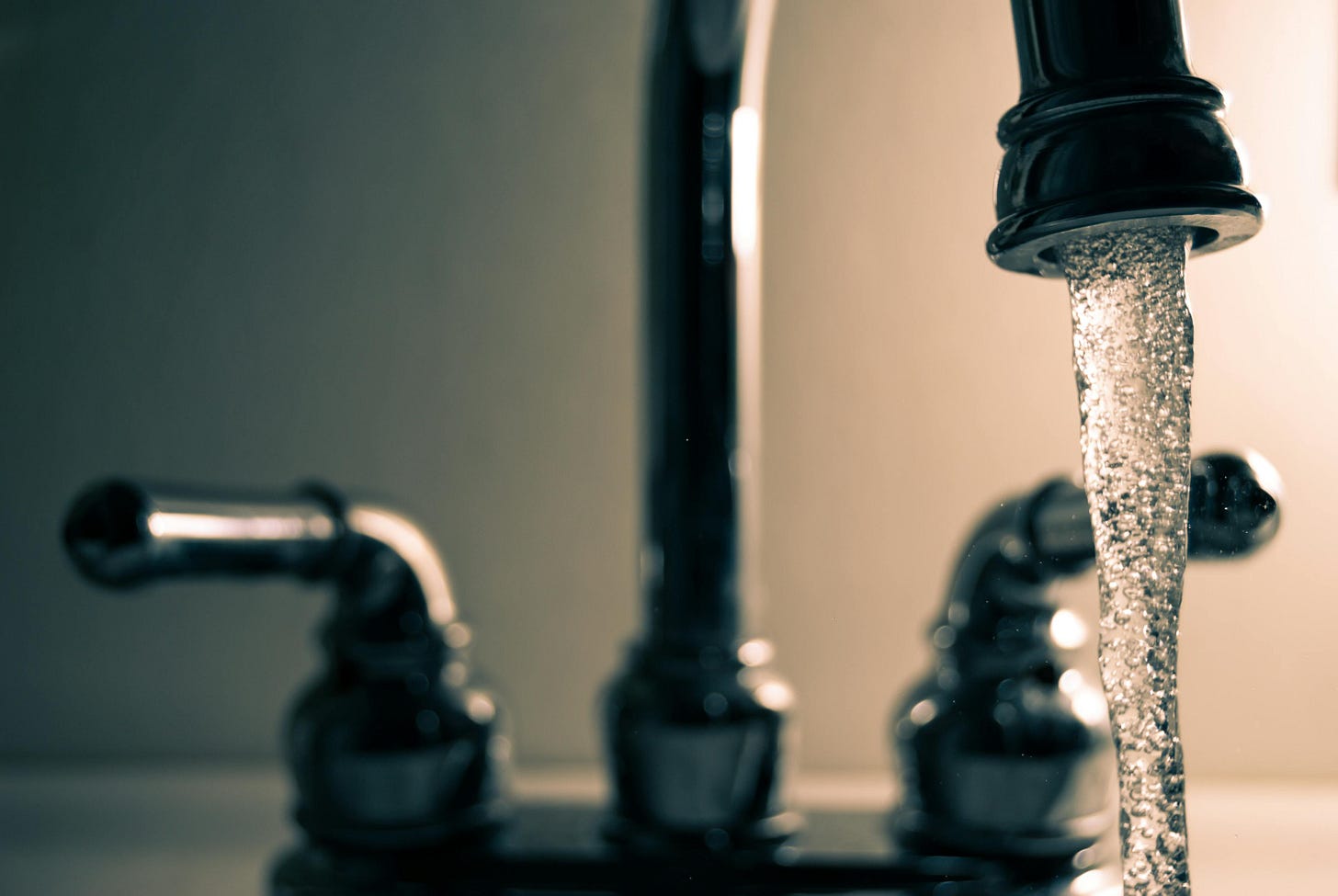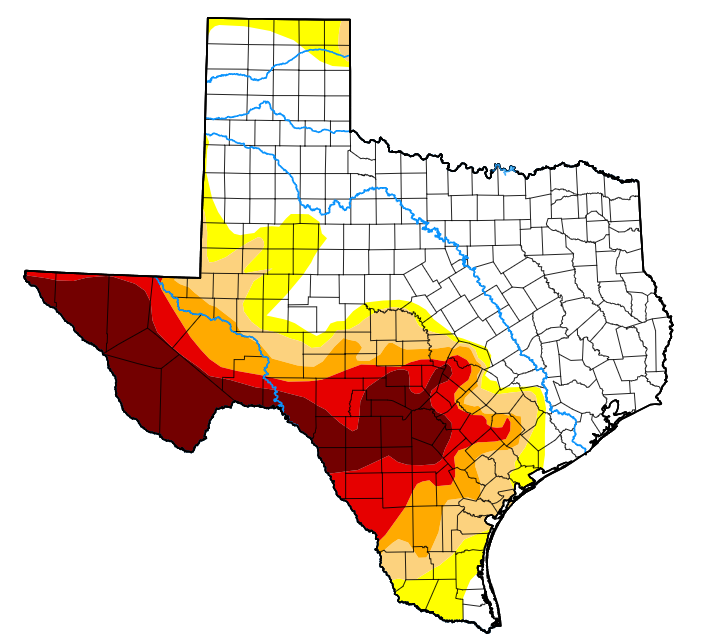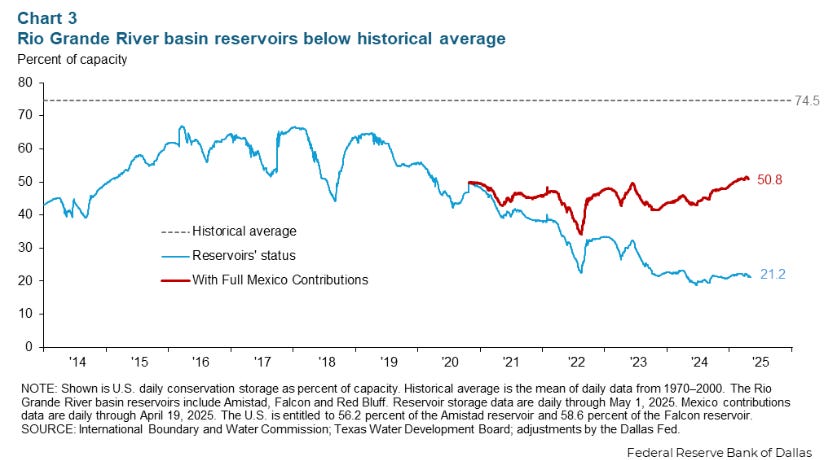Did The 89th Legislature Address Texas' Water Problems?
You can’t solve a water crisis with culture wars.
Over the last several years, Texas has experienced severe droughts, growing water shortages, aging and inadequate water infrastructure, episodes of water contamination, depletion of critical aquifers, and conflicts over water rights. These issues threaten communities, agriculture, and industry alike. While we all know that the Republicans will go to Austin and play their culture war games, with Texas being in such a severe water crisis, we’re left to wonder, did the Legislature do anything to address the situation?
I’ve spent all week sifting through the water legislation that passed, most of which has already been signed into law by Governor Abbott. The question Texans should be asking right now is, “Was it enough?” Let’s dig deeper into the water policies passed this session and find out.
What are Texas’ water problems?
Start with drought. It’s always been part of life here, but climate change is turning up the heat, literally. Hotter days, less predictable rain, longer dry spells. What used to be rare is now routine. And the old “drought of record” from the 1950s? That’s starting to look mild.
Then there’s the population boom. Texas has added millions of people in the last decade, and they all need water. Cities like Austin, Dallas, and Houston are stretching reservoirs built for far smaller populations. Conservation efforts help somewhat, but demand is outpacing supply. Some areas could reach their limit by 2030, especially during drought years.
Agriculture doesn’t help. It consumes more water than any other sector, approximately 70% in dry years, primarily sourced from aquifers that are depleting rapidly. And then there’s oil and gas. Fracking in the Permian eats up millions of gallons per well. A few companies are reusing wastewater, but not nearly enough. Even power plants are sweating, literally, when water levels fall too low to cool their systems.
Add crumbling infrastructure to the mix. We lose over 130 billion gallons of water a year due to leaky pipes, and too many water systems are one pipe break away from collapse. Small towns can’t afford repairs, and big cities keep kicking the can down the road.
But the biggest problem? The way Texas manages water, if you can call it that. It’s a patchwork of siloed agencies, outdated laws, and reactive politics. Groundwater and surface water are regulated separately. Planning is fractured. And thanks to the “rule of capture,” you can legally drain the aquifer under your land even if it screws over your neighbors.
Bottom line? Every sector, rural, urban, and industrial, is feeling the pressure. From boil notices to stalled development, from dry taps to dry crops, Texas is in trouble. And without serious, coordinated action, it’s only going to get worse.
What legislation was passed to address our water crisis this year?
The most significant move our Legislature took was HJR7, which allocates $1 billion per year to water projects over the next 20 years, but only if voters approve it in November during our Constitutional Election.
HB500 also gave a one-time investment of $2.5 billion into the water fund.
Texas 2036 estimates that the state will need nearly $154 billion by 2050 for water infrastructure, including $59 billion for water supply projects, $74 billion for addressing leaky pipes and infrastructure maintenance, and $21 billion to repair broken wastewater systems.
If the Constitutional Amendment in November passes, Texas will still be short $132 billion, according to Texas 2063’s estimates.
HB29 takes a small swing at the problem. It requires municipal utilities to report how much water they’re losing, and penalizes them if they don’t. In other words, the state is finally asking water providers to admit when they’re bleeding out, but there’s no money in this bill to plug the leak. So, if you’re a small town with cracked pipes and no budget? You’re out of luck.
Texas runs on aquifers. And we’re pumping them dry. From the Ogallala in the Panhandle to the Edwards in Central Texas, we’re sucking up water faster than nature can refill it. Meanwhile, local Groundwater Conservation Districts (GCDs), which are responsible for protecting those aquifers, range from well-meaning to completely ineffective.
This session threw them a lifeline.
HB2078, HB2080, and SB1583 try to bring some sanity to aquifer planning and local enforcement. These bills encourage Groundwater Conservation Districts (GCDs) to coordinate more strategically and give TCEQ a bit more muscle when it comes to oversight.
It’s a step in the right direction, but let’s not kid ourselves. None of this touches the root of the problem. Texas still clings to the “rule of capture,” which says if you own the land, you can pump every last drop from the aquifer beneath it, even if your neighbor’s well runs dry. Until that law changes, we’re just rearranging the deck chairs on a sinking aquifer.
Thousands of Texans, mostly in poor, rural, or border areas, still live without safe running water. It’s 2025. And it’s a disgrace.
SB1967 and SB1261 expand funding and improve eligibility for economically distressed communities to fix failing water systems. SB2204 streamlines the grant process, making it less burdensome for small towns seeking to access basic infrastructure funds.
It’s one of the more promising parts of the session. If these programs are implemented correctly, they could finally help colonias and rural communities repair broken pipes, rebuild treatment plants, or even access clean water for the first time. But, as always, it comes down to who decides where the money goes, and the Texas Water Development Board doesn’t exactly have a glowing equity record.
Texans love the idea of “new water.” But desalination is pricey and slow, and water reuse still weirds people out, even though most of us are already drinking recycled sewer juice whether we admit it or not.
SB2885 allows for the use of reclaimed water in aquifer storage and recovery projects. SB480 facilitates easier collaboration between local governments on water research and planning. These are smart, forward-looking bills, but they are long-haul solutions. They won’t fix the busted pipes or dry taps hitting rural Texas today.
SB2662 gives the Public Utility Commission actual teeth to enforce drought contingency plans. HB517, SB1633, and SB783 aim to end the HOA nonsense, making it harder for homeowners’ associations to penalize people for collecting rainwater or planting drought-tolerant landscaping. We still don’t have meaningful statewide limits, but maybe we’re inching toward common sense.
SB1268 updates Texas Water Development Board rules to improve long-term planning.
So, was it enough?
Not even close.
Sure, the Legislature tossed out a few lifelines, some funding here, a reporting requirement there, a handful of reforms with just enough teeth to say they “did something.” However, Texas is facing a multi-billion-dollar water crisis, and lawmakers have treated it as a PR problem rather than a planetary one.
They didn’t touch the “rule of capture,” the single most broken piece of water law in the state. They didn’t fund the $132 billion shortfall. They didn’t mandate real conservation. And they sure as hell didn’t confront the oil and gas industry’s water use because, God forbid, a fracking company be asked to tighten the spigot while a colonia kid still drinks from a hose.
Nothing passed to stop groundwater from being turned into a speculative commodity. Nothing passed to regulate private water marketing schemes that let corporations suck up rural water and ship it off to suburbs. Nothing passed to consolidate planning between agencies, fix the fractured mess of regional authorities, or give us a single, unified water strategy that isn’t just “pray it rains.”
So yes, some good bills passed. And if voters approve the constitutional amendment in November, a little money might start flowing. But what’s in this package? It’s a start. Not a fix.
Because the truth is, Texas can’t solve a climate-fueled, population-driven water crisis with half-measures and wishful thinking. We need coordinated policy, sustained investment, and political courage. And until that shows up in the Capitol, Texans will keep watching water drip through the cracks, literally and legislatively.
Every one of these problems, from drought and infrastructure failure to groundwater depletion, contaminated water, unchecked corporate abuse, and the looming price tag to fix them all, has one common denominator….
Republican control.
It’s Republicans who gutted environmental oversight. Republicans who let oil and gas write the rules. Republicans who’ve starved public infrastructure, ignored climate science, and clung to outdated laws like the “rule of capture” while the aquifers vanish beneath us. And it’s Republicans who treat every water crisis like a photo op instead of a policy failure.
The climate crisis is here, and Texas is feeling it first and worst. Longer droughts, stronger floods, hotter summers, vanishing water. But don’t expect real solutions from the people who still think climate change is “up for debate.”
Until Texans get serious about removing this Republican regime, root and branch, we’re going to keep living with the consequences. Dry wells. Boil notices. Cracked pipes. Empty reservoirs. And billions of dollars we don’t have to fix what their greed and negligence broke.
It’s not just bad policy. It’s political malpractice. And it’s past time we hold them accountable for it.
LoneStarLeft is a reader-supported publication. To receive new posts and support my work, consider becoming a free or paid subscriber.
Follow me on Facebook, TikTok, Threads, YouTube, and Instagram.






You can’t fix a collapsing aquifer with press releases and prayer breakfasts. Until they take on the rule of capture and rein in corporate water grabs, this is just spiritual bypassing disguised as policy. Texans aren’t thirsty for more culture wars — they’re thirsty for actual water. And it’s running out while the Legislature fiddles.